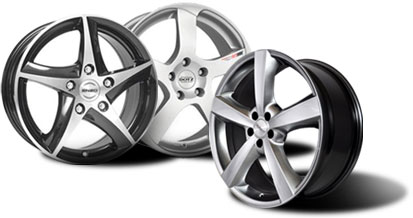The tightening torque plays an important role when changing tyres yourself. Use the following guide to find out what you need to pay particular attention to with alloy wheels and why the torque spanner is indispensable.

Alternatively referred to as tightening torque, torque indicates how tight a screw must be in its counterpart without being overtightened. The specification is made in Newton metres (Nm) as the overarching unit. Newtons indicate the amount of force required to tighten the wheel nuts or wheel bolts. The length in metres refers to the length of the lever in the form of a torque spanner with which you tighten or, if necessary, retighten the bolts.
It is important that you set the correct tightening torque on your torque spanner. The range of possibilities varies between the minimum and maximum values available to you.
Also make sure that the torque spanner is equipped with a reversing lever that allows you to change the direction of rotation. This enables you to loosen bolts before changing the rims on your vehicle.
For a normal car, expect a value of between approx. 80 Nm and 160 Nm. It is naturally higher for vans or vans, as each wheel has to carry more weight. Overall, there is a wide range, which is why it is important to pay attention to the correct specifications. There are various factors that are important when tightening the wheel bolts on your rim. These mainly include the two points listed below:
You can assume that there are alternatively 4 or 5 bolts for fastening the rims to the car. When switching to alloy rims, however, other selection criteria are important. Information on the dimensions of the original wheels can be found in the registration certificate.
This raises the question of what happens if wheel nuts or wheel bolts are too loose after tightening? It can actually lead to dangerous situations on the road if they come loose and the wheel suddenly becomes independent and slips out of its anchorage. Pay attention to any unusual noises after a wheel and rim change. They could be an indication of an imminent dangerous situation.
On the other hand, if the tightening torque is too high, there is a risk that the bolts and threads will be damaged. In extreme cases, this can lead to irreparable material damage and defects in the wheel arch area, including the brake discs.
It is not everyone's cup of tea to change tyres or replace existing complete wheels themselves. If required, we can offer you the service of sending new rims and tyres to one of our partner workshops in your area. There, the tyres are changed quickly and reliably using adjustable pneumatic wrenches with their distinctive rattling noise, without you having to worry about any technical details. You bring your vehicle there and pick it up again on the same day or the following day, depending on the arrangement and processing time.
As different specifications are given for each car, there are several ways to determine the correct torque for systems with wheel nuts and wheel bolts. These include the following:
Note for our customers: When searching for the right alloy wheels in our online shop, you can view or download the corresponding wheel certificate for each model as a PDF so that you have all the relevant information at a glance.
If you do not carry out the wheel change yourself but commission a workshop, you will be advised to retighten the wheel nuts or wheel bolts after approx. 50 to 100 kilometres.
In principle, this is a precautionary measure that you should follow. This also applies to changing tyres yourself, as anyone can make mistakes. Set the required torque on your torque spanner again and retighten all the tyres.
It is important that the screws or nuts are tightened in a clockwise direction. It is recommended that you first set half the torque and then the full torque on your torque spanner. Check all wheels and tighten the diagonally opposite bolts.
Ideally, you should keep the tool handy in your car so that you can carry out this procedure on the road whenever you need to. In addition to changing rims, the check procedure is also recommended if a longer holiday trip is on your agenda, because nothing is more annoying than a flat tyre while you are looking for a break from everyday life.
As an established and experienced online retailer, we are one of the lealeading suppliers in Europe. We offer a large selection of sporty and stylish alloy wheels from well-known manufacturers such as AEZ, RC-Design and BBS. You can find the right models using our easy-to-understand alloy wheel configurator. You can narrow down your search by entering a vehicle and type in the relevant fields. The procedure is identical if you order cheap tyres or complete wheels from us as part of a special package.
If you have any questions, please contact our customer service by telephone. They will be happy to help and advise you. We look forward to hearing from you!